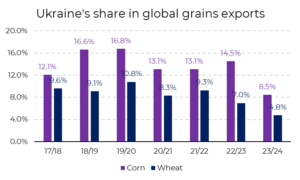Renewal of the Black Sea Grain Corridor and Its Repercussions
Understand what it is, why it was created, and its impact on the global grain market
Commodity markets are directly impacted by the political and economic decisions of countries around the world. When a major conflict occurs, like what’s been going on between Russia and Ukraine since February of 2022, the production and distribution of agricultural goods can be seriously affected, putting food security at risk. This was the context in which the Grain Corridor was created, and it’s just been renewed for another 60 days.
The two countries that continue at war are major commodity producers, mainly of wheat, cereals, oil, and natural gas. At the beginning of the conflict, speculations had already caused concern over price increases and the possible lack of wheat worldwide, and natural gas, mainly in Europe.
The impacts of this agreement were positive, both for the countries, which were able to maintain their exports, and for the rest of the world, which can be more reassured due to lesser inflation as well as possible shortages of these products. In this text, we’ll look a bit more at what the Grain Corridor is and how it works.
What is the Grain Corridor?
The Black Sea Grain Corridor was established on July 22, 2022, as a collaborative effort between Russia and Ukraine, despite the fact the two countries have been at war since February 2022. The United Nations (UN) and Turkey also gave their support to the initiative, allowing Ukraine to resume its exports.
Ukraine used to export 6 million tons of wheat a month while at peace, according to the Ukrainian culture minister, Mykola Solskyi. However, when the war started, a large amount was stored as stock, without any possibility of leaving the country, thus harming the local economy, while impacting the global economy and putting world food security at risk.
Faced with this situation, the UN mediated an agreement between Ukraine and Russia, supported by Turkey, called the Black Sea Grain Initiative. The official ceremony took place in Istanbul, a neutral city outside the conflict.
This agreement made it possible again to export grain, other foodstuffs, and fertilizers from three important ports in Ukraine to the rest of the world. The vessels that pass through the corridor must be inspected in Istanbul, to guarantee the safety of the operation.
The route is 320 nautical miles long and connects three key Ukrainian ports – Odesa, Chornomorsk, and Yuzhny – with inspection areas located in Turkish territorial waters.
What have been the impacts of the Grain Corridor on commodity markets?
Ukraine is currently exporting about 15% of the world’s maize and 7% of its wheat, making it extremely important for global food security. Of these totals, 22% are destined for middle and low-income countries, according to the JCC (an acronym for the Joint Coordination Center, a team made up of representatives of the three countries and the UN).

With the corridor active, total Ukrainian shipments of wheat, corn, and barley could reach 6 million tons per month. When the corridor’s closed, and transport must go by rail only, this number drops to just 2 million.
The agreement, which was established with a period of 120 days to be reviewed, has now reached its third renewal round. Since it was initially signed, 953 ships, carrying 30 million tons of food to 45 countries, have sailed.
The Latest Renewal
This month, the Grain Corridor Agreement was extended again, valid for another 60 days. Though the extension exerts downward pressure on wheat and corn prices in the short term, next-crop exports remain at risk.
Even so, from Russia’s point of view, the possible non-extension of the Grain Corridor Agreement in July seems unattractive as it could lead to retaliation by Western countries, hurting Russia’s export potential.
As a result, the agreement’s non-extension would have a major impact on wheat markets, as it would affect two of the largest exporters in the world and their exports in a scenario of already tight global inventories. The same doesn’t apply so much to corn, given the greater supply expected for the next harvest in several regions, including Europe.
Esse cenário é um bom exemplo que não nos deixa dúvidas: o mercado de commodities é muito volátil. Mesmo quando não está sendo impactado por um conflito internacional, o cenário político e econômico do Brasil e do exterior influenciam na formação de preço. Assim como as taxas de câmbio, que também podem variar.
This scenario is an example that leaves no doubt: commodity markets are very volatile. Even when they’re not impacted by any international conflict, political and economic situations in Brazil and abroad influence price formation (as well as exchange rates, which also vary greatly).
That is why it’s essential to plan in order to provide more predictability and security for the future of your business. Using hedging strategies is the best option to avoid unpleasant surprises in the financial planning of those who work in the commodity chain.
hEDGEpoint puts together the knowledge of specialists with risk management products through technology and customized consulting to always offer you the best experience in futures operations.
We’re globally present and always prepared to serve you, at any time and in any place. Get in touch with us to learn more about how to use this instrument to favor your business.






